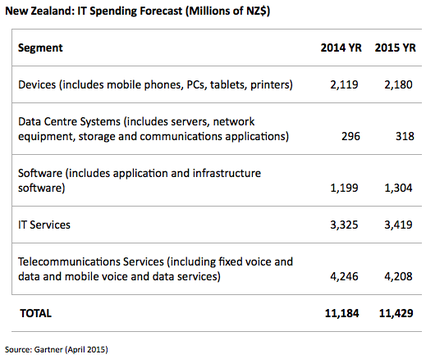Devices, data centres, software? What does NZ ICT industry spend its money on?
- 10 April, 2015 06:04

In New Zealand, spending on technology products and services is forecast to grow to NZ$11.4 billion in 2015, an increase of 2.2 percent from last year.
Including both enterprise and consumer technology spending, according to research analyst firm Gartner the Kiwi ICT industry will spend most of its money this year on telecommunications services, including fixed voice and data, as well as mobile voice and data services.
Measuring IT spending forecast in millions, during 2015 Gartner expects Kiwi organisations to invest around $4.2 billion around telco services, closely followed by a $3.4 billion commitment to IT services across the country.
Businesses are also splashing the cash on devices, including mobile phones, PCs, tablets and printers, with companies expected to fork out as much as $2.1 billion on products this year, while software spend, including application and infrastructure and software coming it at around $1.3 billion.
Further down the line, data centre systems, including servers, networks, equipment, storage and communications applications will hit the $318 million mark, up slightly from 2014 spend of $296 million.

Across the ditch in Australia, spending on technology products and services is forecast to grow to A$78.7 billion in 2015, an increase of 4.2 percent from last year.
With a strong focus around IT and Telecommunications Services like New Zealand, Australian organisations have also increased spending on devices and software spend, followed lastly by data centre investment as both markets provide similar trends.

Globally speaking however, worldwide IT spending is set to shrink to US$3.66 trillion in 2015, a 1.3 percent decrease from 2014, with Gartner citing the rising dollar as chiefly responsible for the slowdown.
"We forecast U.S.-dollar-valued worldwide IT spending in 2015 to shrink by 1.3 percent, down from 2.4 percent growth forecast in last quarter's update," says John-David Lovelock, research vice president, Gartner.
“However, this is not a crash, even if it looks like one. The recent rapid rise in the value of the U.S. dollar against most currencies has put a currency shock into the global IT market.
“Taking out the impact of exchange rate movements, the corresponding constant-currency growth figure is 3.1 percent, only off 0.6 percent from last quarter's update.
"Such are the illusions that large swings in the value of the dollar versus other currencies can create.
Page Break
"However, this illusion masks a bigger issue that has real implications. Every product or service that has a U.S. dollar-based component must have those costs covered at the lower exchange rate.
“The simple implication is that there will be price rises. However, there are many other market forces at work — protecting U.S. dollar profits will require a nuanced and multifaceted approach involving pricing, partners and product management.”

The U.S. dollar spending on devices (including PCs, ultramobiles, mobile phones, tablets and printers) for 2015 is forecast to decline 1.2 percent to $685 billion.
Spending for all devices in 2015 was revised down partly due to a slowdown in PC purchases in Western Europe, Russia and Japan, countries where local currency has devalued against the dollar.
The mobile phone market is not as affected by the currency shifts. Substantial change in the phone mix in emerging markets toward lower-priced smartphones negates price increases of premium phones, resulting in flat phone average selling prices between 2014 and 2015.
Data centre system spending is projected to reach $142 billion in 2015, an increase of just 0.4 percent from 2014.
External controller-based storage, enterprise network equipment and servers have all been impacted by the depreciation of some local currencies against the U.S. dollar, but the server segment has seen the biggest impact due to the greater pricing pressure that server vendors are exposed to, due to their relatively lower margins.
Spending in the enterprise software market is on pace to total $320 billion in 2015, a 2.3 percent increase from 2014. Nevertheless, this is a downward revision from the last forecast and is the result of a substantial reduction in the forecast for office suite spending, reflecting the acceleration of Office 365 adoption.
Office 365 is disrupting traditional revenue flows. Its cost is prorated over the life of the subscription, resulting in significantly lower revenue growth as users transition away from the on-premises model.
IT services spending will contract slightly to $942 billion in 2015, down from $948 billion in 2014. The largest reductions were made in implementation services, particularly in the U.S.
Although the oil and gas industry is only 1 percent of the IT services market, oil and gas buyers historically react quickly when their prices drop, often cutting back on spending 20 percent or more.
Because the U.S. is a large oil producer and a large market for IT services, the largest spending reductions on services is expected to take place in the U.S. through 2015 and 2016, with an early impact on implementation services.
Growth in spending on telecom services is predicted to shrink by 2.6 percent in 2015, to total $1.57 trillion.
Among the more prominent changes affecting multiple regions were reductions in total connections for developed markets such as the U.S. and several Western European nations, as growth in data-only connected devices and multi-SIM connections were not as high as previously expected.

